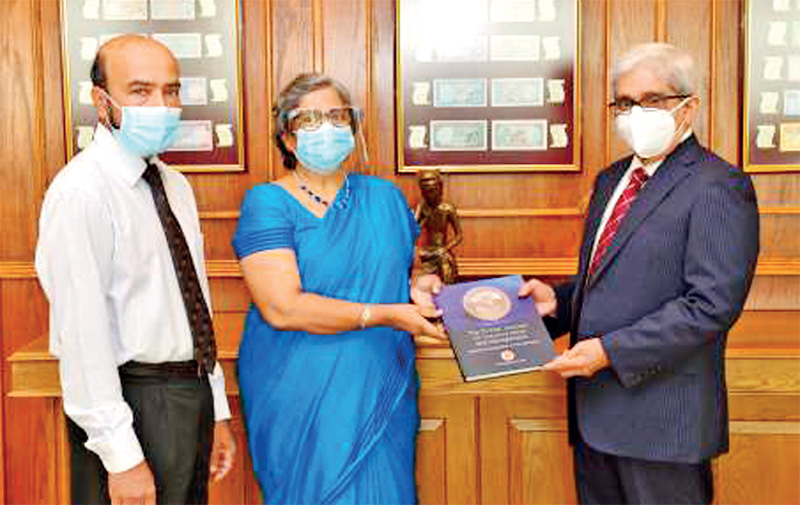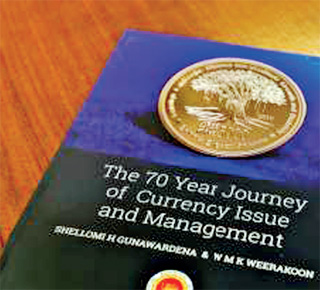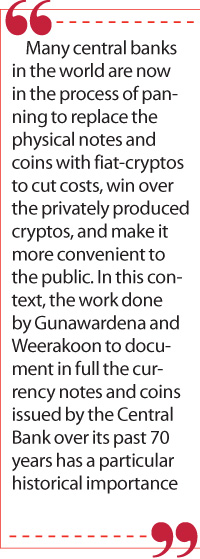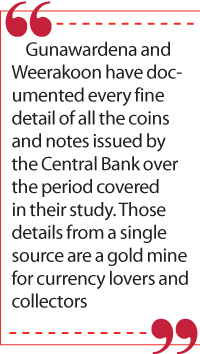Wednesday Jul 02, 2025
Wednesday Jul 02, 2025
Monday, 26 July 2021 00:30 - - {{hitsCtrl.values.hits}}

Co-authors Shellomi H. Gunawardena and W.M.K. Weerakoon handing over the first copy of the publication to CBSL Governor Prof. W.D. Lakshman
 A book on currency
A book on currency
Numismatics is an art, science, hobby, and profession. Only those who collect, study, and research coins, tokens, symbols, and notes – called numismatists – would know the complexity and difficulty in practising this costly hobby.
To help them, two researchers from the Currency Department of the Central Bank, Shellomi H. Gunawardena and W.M.K. Weerakoon, have laboriously documented the currency notes and coins issued by the Bank in the last 70-year period. The book titled ‘The 70 Year Journey of Currency Issue and Management’ has been released marking the Bank’s 70th anniversary.
 Recognition of the integrity of currency officers
Recognition of the integrity of currency officers
The book has been ‘dedicated to those who have served, continue to serve, and would serve the Central Bank of Sri Lanka with integrity and accountability and specially to staff of the Currency Department who carry out an extraordinary service to the Nation’. Just two examples are sufficient to illustrate this point relating to the staff of the currency department.
Transporting currency to Anuradhapura and Matara
The first relates to the risks which the officials in the Currency Department took when they transported live currency notes from the main Central Bank building to its Matara and Anuradhapura offices at the height of the Second Eelam War. Currency had to be delivered to these regional offices for issue to people in those regions and in the case of the Anuradhapura Office to be airlifted to Jaffna for payment of salaries of the security personnel and the other Government officers.
In one consignment, currency notes of different denominations to a value of about Rs. 1 billion had to be sent. This was a top-secret operation due to two reasons. One is that had LTTE got wind of these currency consignments, with their ability to launch an attack in any part of the country, it would have ended in an irreversible catastrophe. The other is the possibility of some Central Bank officers colluding with an outside party to stage a mock robbery. But the integrity of the officers in the currency department was so high that none of such things happened and we were able to send currency consignments twice a month to Anuradhapura and Matara.
LTTE attack in 1996 and discharging duties without failure
The other occasion was in 1996 when LTTE exploded a powerful bomb in front of the main entrance to the bank building. The bomb had destroyed the Banking Hall on the ground floor where the currency operations were done with customers and caused a major fire in the floors above it. At that time, the Currency Department officers had taken out about Rs. 800 million for daily business with the public and they could have walked out with that money without being seen by anyone. There was the risk of the building collapsing due to the bomb and the consequential fire.
Yet, the Currency Department officers had collected all the currency, locked it in the metal trunks they had taken out, carried the boxes on their shoulders to the basement vaults in total darkness, and come out of the building only after they had been safely deposited in the vaults. That was the degree of integrity, commitment and devotion of the officers in the Central Bank in general and those in the Currency Department in particular.
 Currency officers are lovers of currency
Currency officers are lovers of currency
There is a unique feature of the officers in the Currency Department. They develop an extreme love affair with the currencies they handle on a day-to-day basis. I too was infected by this ailment when I was posted to the Currency Department in 1991 as its head. They are all officers who work underground in the basement of the bank building not seen by others in the bank or members of the public. The currency notes they handle are not the most hygienic materials which a healthy person would come across in his life. Yet, the officers in the Currency Department, I have noted, handle them delicately as if they are wedded to currencies.
Most of them spend their pastime doing extensive research on currencies of the world in general and those in Sri Lanka in particular. The outcomes of those research studies have been shared by them through publications done from time to time. Previously, T.M.U. Sallay released a book covering Sri Lanka’s currencies from 1938 to 1985. Following Sallay’s footsteps, Gunawardena and Weerakoon have released a sequel to Sallay by covering the currency issue by the Central Bank from its inception to 2020.
They have eloquently expressed their love with currency in the introduction to the book as follows: “We, the authors, are proud to have served in the Currency Department of the Central Bank for many years and consider it a privilege to share the knowledge and experience garnered over the years through this co-authored publication. Gunawardena who came from the mainstream central banking to the Currency Department was its additional head at the time of co-authoring this book. For Weerakoon, Currency Department was his lifelong career in the Bank growing, maturing, and excelling with currencies.
Challenge by cryptos
Appreciating the contribution of the two authors and all others who had supported them to knowledge, Central Bank Governor Deshamanya Prof. W.D. Lakshman has said in his message to the publication that it is “particularly important at this juncture in time, when digital cash will most likely be the dominant payment mode of the country in the years to come”. This is in fact a forewarning to currency lovers and numismatists. The era of enjoying the beauty and the glamour of the present physical currency notes will be a thing of the past with only nostalgic memories when currency notes and coins get dematerialised and become an electronic signal in the cyberspace with the onset of cryptos in the future. Many central banks in the world are now in the process of panning to replace the physical notes and coins with fiat-cryptos to cut costs, win over the privately produced cryptos, and make it more convenient to the public. In this context, the work done by Gunawardena and Weerakoon to document in full the currency notes and coins issued by the Central Bank over its past 70 years has a particular historical importance.
 Coinage in ancient Lanka
Coinage in ancient Lanka
The book contains seven chapters and two appendices. Gunawardena and Weerakoon have taken the readers through the historical evolution of currency in Sri Lanka from ancient times to date and how the legal structure for the Central Bank of Sri Lanka to issue currencies was framed. Coins-based means of payment had been used in ancient Lanka which had been an important trading nation from very early times. Drawing on historical records, Gunawardena and Weerakoon have documented that the earliest coins found from Lanka had been those of Indian origin with different shapes, sizes, weights, but punched with common symbols and characters. They were called Puranas or Kahapanas.
From around the 1st century CE, there were round copper and gold coins. In addition to the locally minted coins, there had been coins of Arabian, Greek, Roman, Chinese, and Indian origin testifying to the country’s role as an international trading hub in ancient times. During the colonial period beginning from early 16th century, coins belonging to the respective colonial power, namely, the Portuguese, Dutch and the British, had been in use. However, the currency system in the country had gone through major transformation only in the latter part of the 19th century under the British rule.
Currency Board system
With this brief introduction serving as the background, Gunawardena and Weerakoon have set on to their main task of writing the book, namely, documenting the currency issue, management, and its modernisation done during the central banking era beginning from late 1950. Prior to this, currencies had been issued in the island, under a system known as the Currency Board established in 1884. Under the currency board system, there was a self-discipline in the issue of currency since it had been linked to the available foreign exchange reserves with the Board.
That foreign exchange had been Indian currency which in turn had been linked to the British Sterling Pound. Hence, in effect, Ceylon currency had been linked to the British Sterling Pound. However, with the establishment of the Central Bank in 1950, this system was abolished, and the Central Bank was allowed to decide on its own prudential currency management techniques.
Demonetisation of currencies
The Central Bank which continued with the currencies issued by the Currency Board in its first few years of operation had cancelled them in 1955 and began the issue of its own currencies from that year onward. This was the first demonetisation of currency by the Central Bank, and it was made necessary by the circumstances. However, in 1970, the Central Bank went for another currency demonetisation, this time only the notes of Rs. 100 and Rs. 50, for a different reason.
As Gunawardena and Weerakoon have documented, the purpose of that demonetisation was to capture those who had been evading tax payments and boost the government coffers. This was done under the patronage of the new Finance Minister, Dr. N.M. Perera, who had firmly believed that the rich had been hoarding their wealth in those high denomination notes. Hence, to force them to release their hoarded wealth back to the mainstream economy, these notes were replaced by the issue of a new series of notes.
The legal effect to this move had been given by the enactment of the Prevention of the Avoidance of Tax Act of 1970 by Parliament. The title of the Act itself is misleading since the avoidance of tax is legitimate. If the Government imposes a tax on tobacco, a person can avoid the tax by not consuming the stuff. What is being scored is tax evasion which is a deliberate attempt at hiding the income and evading the tax liability.
Demonetising currencies without consulting the Central Bank
Though Gunawardena and Weerakoon had not pointed it out, this exparte action by the Ministry of Finance had made an indelible black mark to the independence of the Central Bank. As revealed by Edmund Eramudugolla, Ex Senior Deputy Governor of the Bank in his autobiography, Reminiscences of the Central Bank of Sri Lanka, the whole operation had been done by the Ministry of Finance without the knowledge of the Governor William Tennekoon.
This is what Eramudugolla says about this high-handed act: “It was an act of duplicity unworthy of a Minister of Finance whose relations with the Governor of the Central Bank of the country should have been open and healthy, and where statutorily where they are both responsible for the issue of the country’s currency. With the Governor’s signature transcribed in the new notes without his authority and in total ignorance of the issue of the notes, it was an illegal operation and could have been questioned in a Court of Law, but then, where would have this led to? The Minister was able to get the PM on his side by designing the portrait of her late husband with his hand upraised, a symbol of his party, on these notes. The notes were printed not by the Bank’s regular printers, but by Thomas Delarue whom the Minister engaged. The Governor was ignorant of this whole exercise until the notes were brought into the currency division under security and issued to the public who wanted to exchange the demonetised old notes for the new” (pp 57-8).
The disappointed Governor Tennekoon made no protest but chose to leave the Central Bank without seeking re-appointment. In hindsight, we could now say that the demonetisation exercise was a failure from the point of getting the hoarded money into open and boost the government coffers by way of increased tax revenues. The Central Bank had to write off the enormous cost of the operation over several years. The only good sign was the replacement of the portrait of Queen Elizabeth, the Second, that had been in circulation since 1952 with that of a national leader which would anyway have been done when the country became an independent republic within the Commonwealth in 1972.
A must reference book for all
Gunawardena and Weerakoon have documented every fine detail of all the coins and notes issued by the Central Bank over the period covered in their study. Those details from a single source are a gold mine for currency lovers and collectors. The book that has been printed in multicolour and bound in hard cover add further value to it as a reference book. The photos reprinted are finely done, and therefore, the readers would get the feeling of seeing live currency notes when they master the book. Thus, both co-authors should be commended for the useful work they have done.
(The writer, a former Deputy Governor of the Central Bank of Sri Lanka, can be reached at [email protected].)
Discover Kapruka, the leading online shopping platform in Sri Lanka, where you can conveniently send Gifts and Flowers to your loved ones for any event including Valentine ’s Day. Explore a wide range of popular Shopping Categories on Kapruka, including Toys, Groceries, Electronics, Birthday Cakes, Fruits, Chocolates, Flower Bouquets, Clothing, Watches, Lingerie, Gift Sets and Jewellery. Also if you’re interested in selling with Kapruka, Partner Central by Kapruka is the best solution to start with. Moreover, through Kapruka Global Shop, you can also enjoy the convenience of purchasing products from renowned platforms like Amazon and eBay and have them delivered to Sri Lanka.
Discover Kapruka, the leading online shopping platform in Sri Lanka, where you can conveniently send Gifts and Flowers to your loved ones for any event including Valentine ’s Day. Explore a wide range of popular Shopping Categories on Kapruka, including Toys, Groceries, Electronics, Birthday Cakes, Fruits, Chocolates, Flower Bouquets, Clothing, Watches, Lingerie, Gift Sets and Jewellery. Also if you’re interested in selling with Kapruka, Partner Central by Kapruka is the best solution to start with. Moreover, through Kapruka Global Shop, you can also enjoy the convenience of purchasing products from renowned platforms like Amazon and eBay and have them delivered to Sri Lanka.